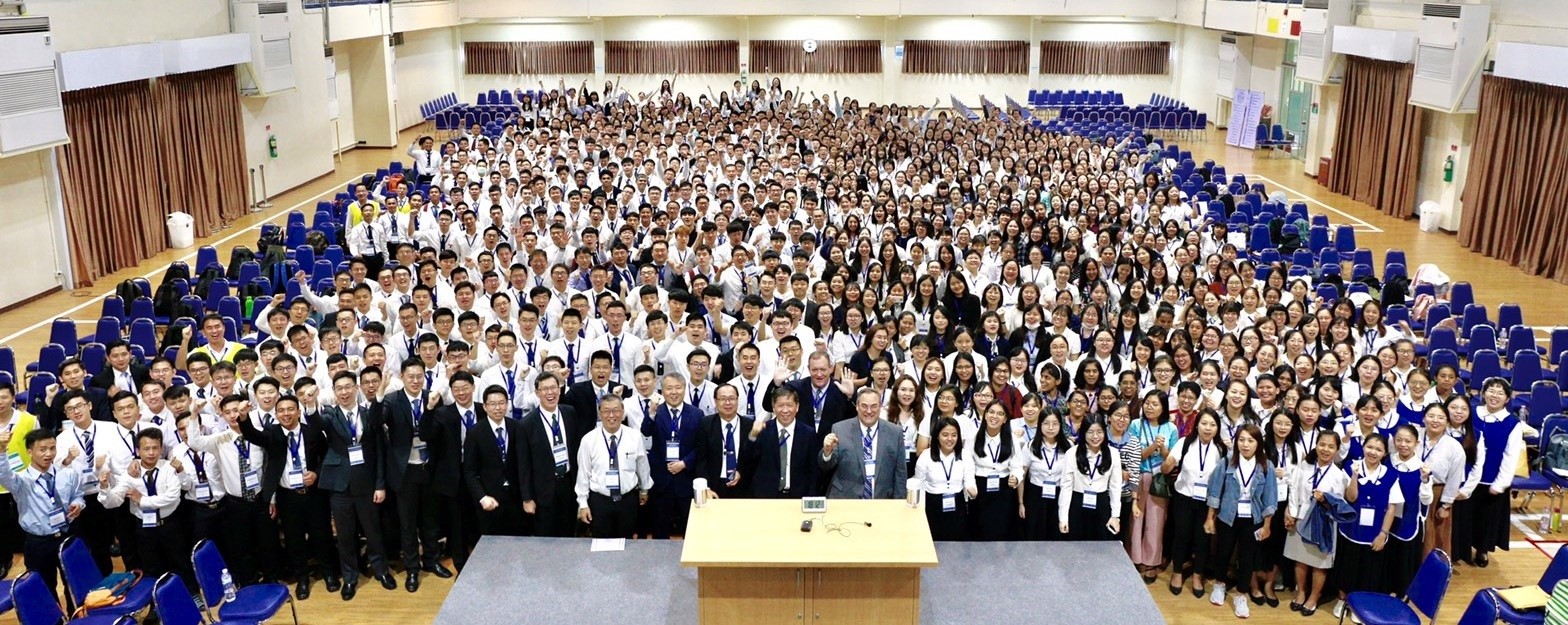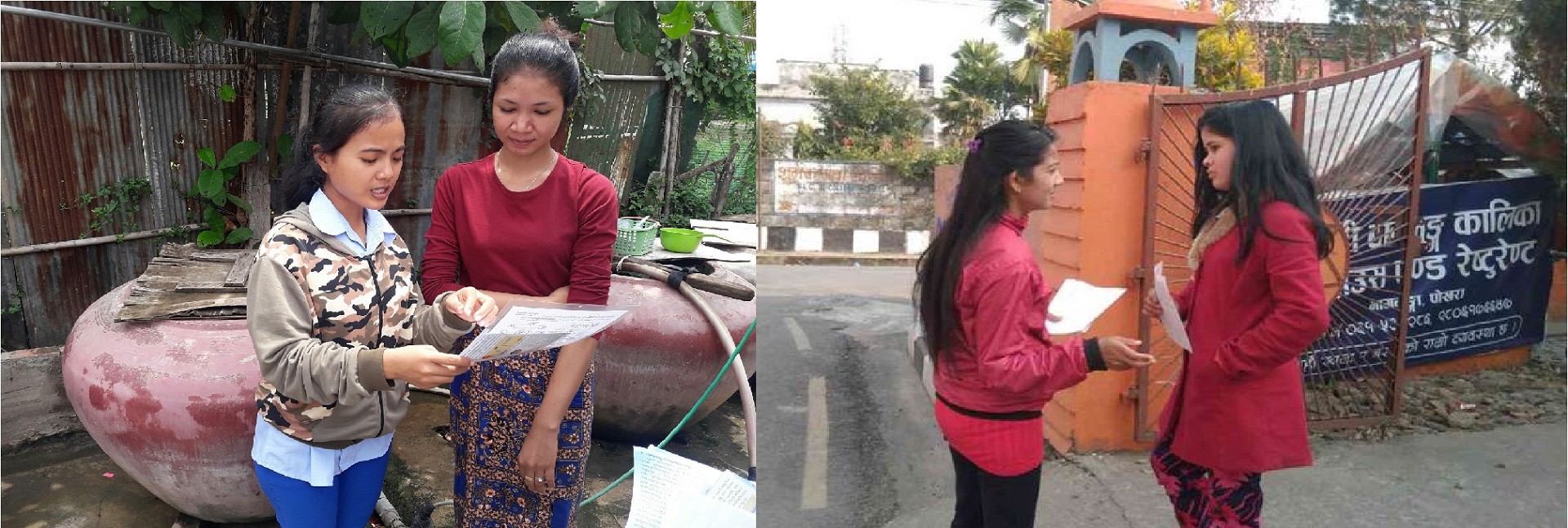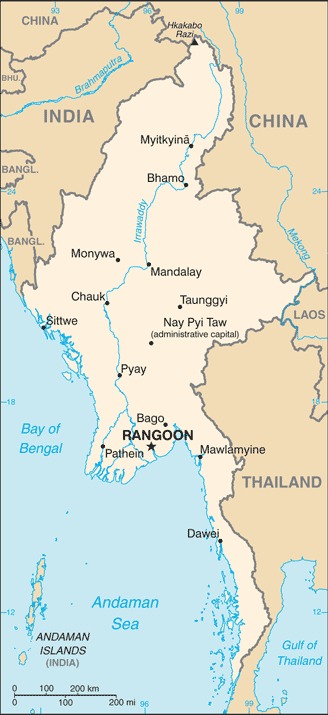Myanmar
Background
Various ethnic Burmese and ethnic minority city-states or kingdoms occupied the present borders through the 19th century. Over a period of 62 years (1824-1886), Britain conquered Burma and incorporated the country into its Indian Empire. Burma was administered as a province of India until 1937 when it became a separate, self-governing colony; in 1948, Burma attained independence from the Commonwealth. Gen. NE WIN dominated the government from 1962 to 1988, first as military ruler, then as self-appointed president, and later as political kingpin. In response to widespread civil unrest, NE WIN resigned in 1988, but within months the military crushed student-led protests and took power. Multiparty legislative elections in 1990 resulted in the main opposition party – the National League for Democracy (NLD) – winning a landslide victory. Instead of handing over power, the junta placed NLD leader (and Nobel Peace Prize recipient) AUNG SAN SUU KYI (ASSK) under house arrest from 1989 to 1995, 2000 to 2002, and from May 2003 to November 2010. In late September 2007, the ruling junta brutally suppressed protests over increased fuel prices led by prodemocracy activists and Buddhist monks, killing at least 13 people and arresting thousands for participating in the demonstrations. In early May 2008, Burma was struck by Cyclone Nargis, which left over 138,000 dead and tens of thousands injured and homeless. Despite this tragedy, the junta proceeded with its May constitutional referendum, the first vote in Burma since 1990. Parliamentary elections held in November 2010, considered flawed by many in the international community, saw the ruling Union Solidarity and Development Party garner over 75% of the seats. Parliament convened in January 2011 and selected former Prime Minister THEIN SEIN as president. Although the vast majority of national-level appointees named by THEIN SEIN are former or current military officers, the government has initiated a series of political and economic reforms leading to a substantial opening of the long-isolated country. These reforms have included allowing ASSK to contest parliamentary by-elections on 1 April 2012, releasing hundreds of political prisoners, reaching preliminary peace agreements with 10 of the 11 major armed ethnic groups, enacting laws that provide better protections for basic human rights, and gradually reducing restrictions on freedom of the press, association, and civil society. At least due in part to these reforms, ASSK now serves as an elected Member of Parliament and chair of the Committee for Rule of Law and Tranquility. Most political parties have begun building their institutions in preparation for the next round of general elections in 2015. The country is preparing to chair the Association of Southeast Asian Nations (ASEAN) in 2014.
Location:
Southeastern Asia, bordering the Andaman Sea and the Bay of Bengal, between Bangladesh and Thailand
Area:
676,578 sq km
Climate:
Tropical monsoon; cloudy, rainy, hot, humid summers (southwest monsoon, June to September); less cloudy, scant rainfall, mild temperatures, lower humidity during winter (northeast monsoon, December to April)
Ethnic groups:
Burman 68%, Shan 9%, Karen 7%, Rakhine 4%, Chinese 3%, Indian 2%, Mon 2%, other 5%
Languages:
Burmese (official)
note: minority ethnic groups have their own languages
Religions:
Buddhist 87.9%, Christian 6.2%, Muslim 4.3%, Animist 0.8%, Hindu 0.5%, other 0.2%, none 0.1% (2014 est.)
Population:
56,590,071 (July 2020 est.)
country comparison to the world: 25
Age structure:
0-14 years: 25.97% (male 7,524,869/female 7,173,333)
15-24 years: 17% (male 4,852,122/female 4,769,412)
25-54 years: 42.76% (male 11,861,971/female 12,337,482)
55-64 years: 8.22% (male 2,179,616/female 2,472,681)
65 years and over: 6.04% (male 1,489,807/female 1,928,778) (2020 est.)
Government type:
Parliamentary republic
Capital:
Rangoon (Yangon)
Time difference:
UTC+6.5 (11.5 hours ahead of Washington, DC during Standard Time)
Economy – overview:
Myanmar is a resource-rich country but still suffers from pervasive government controls, inefficient economic policies, corruption, and rural poverty. Burma is the poorest countryin Southeast Asia; approximately 32% of the population lives in poverty. Corruption is prevalent and significant resources are concentrated in the extractive industries are concentrated in a few hands. The Burmese government has initiated notable economic reforms. In October 2011, 11 private banks were allowed to trade foreign currency. On April 2, 2012, Burma’s multiple exchange rates were abolished and the Central Bank of Myanmar established a managed float of the Burmese kyat. In November 2012, President THEIN SEIN signed a new Foreign Investment Law. Despite these reforms, the Burmese government has not yet embarked on broad-based macro-economic reforms or addressed key impediments to economic development such as Burma’s opaque revenue collection system. Key benchmarks of economic progress would include steps to ensure the independence of the Central Bank, provide budget allocation for social services, and enact laws to protect intellectual and real property. In recent years, foreign investors have shied away from nearly every sector except for natural gas, power generation, timber, and mining. The exploitation of natural resources does not benefit the population at large. The most productive sectors will continue to be in extractive industries – especially oil and gas, mining, and timber – with the latter two causing significant environmental degradation. Other areas, such as manufacturing, tourism, and services, struggle in the face of poor infrastructure, unpredictable trade policies, undeveloped human resources (the result of neglected health and education systems), endemic corruption, and inadequate access to capital for investment. The US initially imposed sanctions on Burma in response to the 1988 military crackdown and the regime’s refusal to honor the democratic opposition National League for Democracy’s 1990 landslide election victory under the leadership of AUNG SAN SUU KYI. In 2003, the US moved from broad-based to more targeted sanctions. In July 2012, as a result of reforms undertaken by President THEIN SEIN and his nominally civilian government, the US to Burma. In November 2012, the US eased the import bank on Burmese products to the US with the exception of jadeite and rubies. Although the Burmese government has good economic relations with its neighbors, significant improvements in economic governance, the business climate, and the political situation are needed to promote serious foreign investment.
GDP (purchasing power parity):
$329.8 billion (2017 est.)
GDP – per capita (PPP):
$6,300 (2017 est.)
Source:
CIA World Factbook







